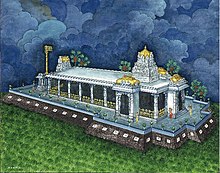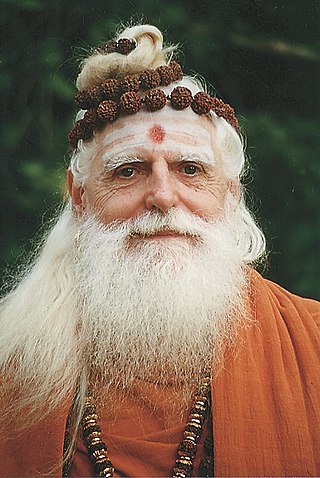
Sivaya Subramuniyaswami was an American Hindu religious leader known as Gurudeva by his followers. Subramuniyaswami was born in Oakland, California and adopted Hinduism as a young man. He was the 162nd head of the self claimed Nandinatha Sampradaya's Kailasa Parampara and Guru at Kauai's Hindu Monastery which is a 382-acre (155 ha) temple-monastery complex on Hawaii's Garden Island.
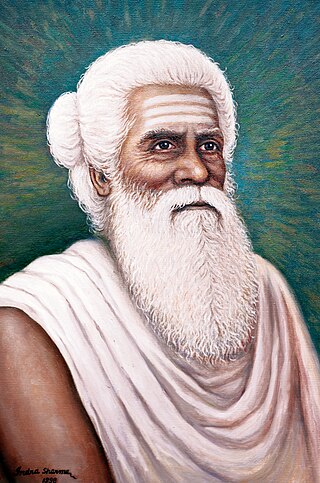
Jnana guru Siva Yogaswami of Jaffna (1872–1964) was a spiritual master, a śivajnani and anatha siddhar revered by Hindus of the 20th century. He had Catholic and Buddhist devotees as well. He was the 161st Jagadacharya of the Nandinatha Sampradaya's Kailasa Parampara. Yogaswami was trained in and practiced Kundalini yoga under the guidance of Satguru Chellappaswami, from whom he received guru diksha (initiation).
Nandinatha Sampradaya is a denomination of Shaivism sect of Hinduism that places great importance on the practice of yoga. It is related to the broader Nath Sampradaya. The self-styled living preceptor and 163rd head of the Nandinatha Sampradaya's Kailasa Parampara is Bodhinatha Veylanswami. It is most popular among Tamil Hindus.

Nandi, also known as Nandikeshvara or Nandideva, is the bull vahana (mount) of the Hindu god Shiva. He is also the guardian deity of Kailash, the abode of Shiva. Almost all Shiva temples display stone images of a seated Nandi, generally facing the main shrine.
Bettadapura is a village located in Mysore district, in the Indian state of Karnataka. The name is derived from two Kannada words, "Betta" and "pura". Betta means "hill" and pura means "town". As per census survey of India 2011, the location code number assigned to Bettadapura is 618171.

Pradosha or Pradosham is a bimonthly occasion on the thirteenth day of every fortnight in the Hindu calendar. It is closely connected with the worship of the Hindu god Shiva. The auspicious three-hour period 1.5 hours before and after sunset is considered as the most suited and optimal time for worship of Shiva on this day. The fasting vow performed during the period is called "Pradosha vrata". A devotee should wear rudraksha, Vibhuti and worship Shiva by abhisheka, sandal paste, bael leaves, fragrance, deepa and naivedya.

Vaidyanatha Ganapati Sthapati was a Sthapati and head of the College of Architecture and Sculpture in the Vastu Shastra tradition ascribed to the sage Mamuni Mayan.

Bodhinatha Veylanswami is a Hindu sannyasin monk and a religious leader, who is the head of Kauai's Hindu Monastery and publisher of Hinduism Today magazine. He is the 163rd head of the self claimed Nandinatha Sampradaya's Kailasa Parampara and Guru at Kauai's Hindu Monastery which is a 382-acre temple-monastery complex on Hawaii's Garden Island. He is known for his initiatives of digitizing the Saiva Agamas, scriptures of the Hindu Saivite religion and the basis for Hindu temple liturgy, making them freely available in digital format, encouraging their study and promoting reform Saivism which purges animal sacrifices mentioned in the Siddhantic scriptures thereby promoting Hindu vegetarianism. The Adi Saiva Sivachariyar priestly community honors him as "The Supreme Acharya who has uplifted and preserved the Agamas and the Agama tradition." Bodhinatha presides over three organizations: Saiva Siddhanta Church, Himalayan Academy publications and Hindu Heritage Endowment.
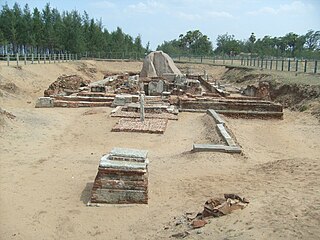
The Murugan Temple at Saluvankuppam, Tamil Nadu, India, is a shrine dedicated to Tamil Hindu deity Murugan. Archaeologists believe that the shrine, unearthed in 2005, consists of two layers: a brick temple constructed during the Sangam period and a granite Pallava temple dating from the 8th century CE and constructed on top of the brick shrine making it the oldest temple in India. The Archaeological Survey of India (ASI) team which conducted the excavation believe that brick temple could be the oldest of its kind to be discovered in Tamil Nadu.
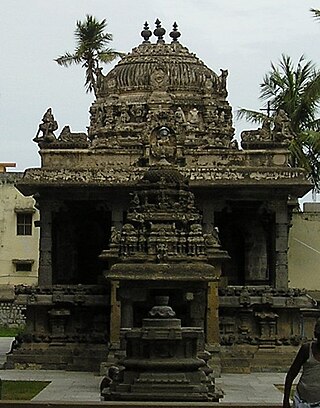
The Jurahareswarar temple is located in the temple town of Kanchipuram in Tamil Nadu, India. Constructed in the Dravidian style of architecture, the temple is dedicated to Shiva, who is worshipped as Jurahareswarar.

A prakaram, also spelled pragaram or pragaaram) in Indian architecture is an outer part around the Hindu temple sanctum. They may be enclosed or open and are typically enclosed for the innermost prakaram. As per Hindu religious practices, devotees start to come around the outer prakarams to the inner most before entering the sanctum.
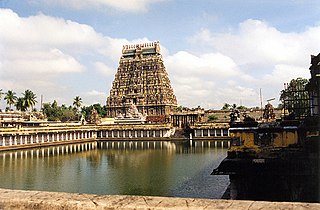
Iconography of Shiva temples in Tamil Nadu is governed by the Shaiva Agamas (IAST:Āgama) that revere the ultimate reality as the Hindu deity, Shiva. Āgama in the Hindu religious context means a traditional doctrine or system which commands faith. Temple worship according to Āgamic rules can be said to have started during the Pallava dynasty in South India, but they were fully under establishment during the Chola dynasty The temples during the Chola period expanded to Sri Lanka and islands in South East Asia. The temple complex was expanding with niches for various deities on the stipulated sides of the sanctum. Lingam was universalised and prakarams (precincts) with subsequent deities came up. The temple parivara expanded considerably during the Chola period. The niches of following Āgamic rules for building Shiva temples in Tamil Nadu, a South Indian state continues even in the modern era. Some of the prime images like that of lingam, Vinayagar and Parvati are present in all the Shiva temples. Almost all the temples follow the same custom during festivals and worship methods with minor exceptions. Most of the Shiva temples in Tamil Nadu and Sri Lanka are built in Dravidian architecture.
Spatika Lingam or Crystal Lingamor Crystal Shivling is a type of Lingam made from quartz. Spatika Lingam is called sphatika Sivalingam, ,(Kannada -ಸ್ಪಟಿಕ ಲಿಂಗ),. Sphatikam in Sanskrit means "made of crystal, crystalline", referring to quartz and alum.

A lingam, sometimes referred to as linga or Shiva linga, is an abstract or aniconic representation of the Hindu god Shiva in Shaivism. It is typically the primary murti or devotional image in Hindu temples dedicated to Shiva, also found in smaller shrines, or as self-manifested natural objects. It is often represented within a disc-shaped platform, the yoni – its feminine counterpart, consisting of a flat element, horizontal compared to the vertical lingam, and designed to allow liquid offerings to drain away for collection. Together, they symbolize the merging of microcosmos and macrocosmos, the divine eternal process of creation and regeneration, and the union of the feminine and the masculine that recreates all of existence.
Kukkuteswara Temple is a Hindu temple in Pitapuram town of Kakinada district, Andhra Pradesh, India. The temple is prominent in both Saivite and Shakta Hindu traditions. It is one of the eighteen Maha Sakthi Peethas considered the most significant pilgrimage destinations in Shaktism. The presiding deity of the temple is Lord Kukkuteswara, a form of Lord Siva as a rooster and his consort Rajarajeswari Devi.
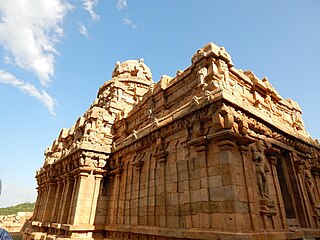
Vijayalaya Choleeswaram in Narthamalai, a panchayat town in Pudukottai district in the South Indian state of Tamil Nadu, India, is a temple dedicated to the Hindu god Shiva, Vishnu and houses the 8th century Jaina Abode. The temple is considered one of the oldest stone temples in South India. The other portions of Narthamalai houses the 8th century Jaina Abode, the Aluruttimalai Jain Caves. The Temple is Constructed in the Dravida style and rock cut architecture, the temple is believed to have been built during the 9th century by Mutharaiyar dynasty kings, the cardinals of Pallavas, with later expansion from the Cholas. The rock-cut architecture is an early example of Cholan Art, continuing the tradition of the Pallavas.

The Kadavul Temple is a Jaffna-Style Hindu temple dedicated to the Shiva located on the Kauai island in the state of Hawaii, USA. It is maintained by the Saiva Siddhanta Church which is also known as Kauai Aadheenam or Kauai's Hindu Monastery.
Satguru Chellapaswami was a 20th-century Sri Lankan Shaiva Hindu Sage. He was the guru of Satguru Yogaswami and was the 160th Jagadacharya of the self claimed Nandinatha Sampradaya's Kailasa Parampara. He lived in the Jaffna peninsula near Nallur Kandaswamy temple. His guru was Kadaitswami.
Thinthirineesvarar Temple is a Hindu temple dedicated to the deity Shiva, located at Tindivanam in Villupuram district, Tamil Nadu, India.
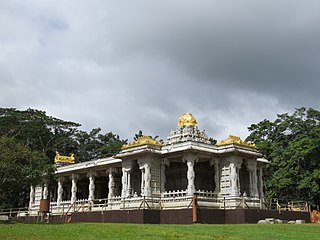
Saiva Siddhanta Church is an organization that identifies itself with the Saivite Hindu religion. It supports the work of the late Satguru Sivaya Subramuniyaswami, a spiritual teacher initiated by Siva Yogaswami of Jaffna with the honorary title Gurudeva. The mission of the church is to preserve and promote the Saivite Hindu religion. Membership in the church extends to many countries in the world, including the US, Canada, Mauritius, Malaysia, Singapore, India, Sri Lanka and several European nations. Members are organized into regional missions with the goal of supporting Saivism in their families, communities, and in the global community under the leadership of Satguru Bodhinatha Veylanswami.



